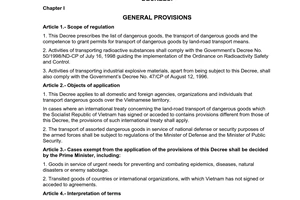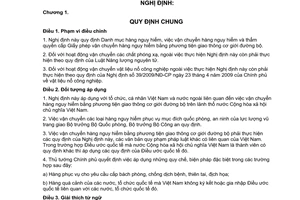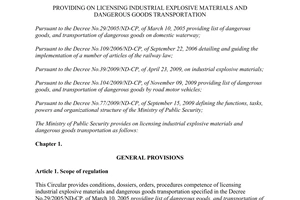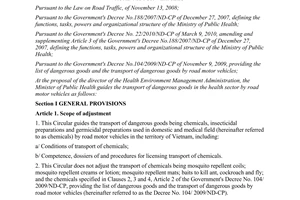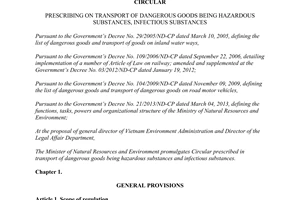Nội dung toàn văn Decree No. 104/2009/ND-CP of November 09, 2009, providing for the list of dangerous goods and the transport of dangerous goods by road motor vehicles
|
THE
GOVERNMENT |
SOCIALIST
REPUBLIC OF VIET NAM |
|
No. 104/2009/ND-CP |
Hanoi, November 09, 2009 |
DECREE
PROVIDING FOR THE LIST OF DANGEROUS GOODS AND THE TRANSPORT OF DANGEROUS GOODS BY ROAD MOTOR VEHICLES
THE GOVERNMENT
Pursuant to the December 25,
2001 Law on Organization of the Government;
Pursuant to the November 13, 2008 Law on Road Traffic;
At the proposal of the Minister of Transport,
DECREES:
Chapter I
GENERAL PROVISIONS
Article 1. Scope of regulation
1. This Decree provides for the list of dangerous goods, the transport of dangerous goods and the competence to grant permits for the transport of dangerous goods by road motor vehicles.
2. The transport of radioactive materials, apart from being subject to this Decree, must also comply with the Law on Atomic Energy.
3. The transport of industrial explosive materials, apart from being subject to this Decree, must also comply with the Government's Decree No. 39/2009/ND-CP of April 23, 2009, on industrial explosive materials.
Article 2. Subjects of application
1. This Decree applies to Vietnamese and foreign organizations and individuals engaged in the transport of dangerous goods by road motor vehicles in the territory of the Socialist Republic of Vietnam.
2. The transport of dangerous goods in service of defense and security purposes of armed forces will be prescribed by the Minister of National Defense and the Minister of Public Security.
3. The transport of dangerous goods by road motor vehicles must comply with this Decree and other relevant legal documents of Vietnam. For cases otherwise provided for by treaties to which the Socialist Republic of Vietnam is a contracting party, these treaties prevail.
4. The Prime Minister shall decide on the application of special regulations and measures in the following cases:
a/ Goods in service of urgent needs for preventing and coping with epidemics, natural disasters and calamities;
b/ Transited goods of countries or international organizations with which Vietnam has not signed or acceded to any relevant treaties.
Article 3. Interpretation of terms
In this Decree, the terms below are construed as follows:
1. Dangerous substances are substances or compounds in gaseous, liquid or solid form which may cause harms to human life and health, the environment or national safety and security.
2. Dangerous goods are goods which contain dangerous substances and, during transport, may cause harms to human life and heath, the environment or national safety or security.
3. Goods consignors are organizations and individuals that consign dangerous goods under their names.
4. Carriers are organizations and individuals that use road motor vehicles to transport dangerous goods.
Chapter II
CLASSIFICATION AND LIST OF DANGEROUS GOODS
Article 4. Classification of dangerous goods
1. Depending on their chemical and physical properties, dangerous goods are classified into nine classes which are subdivided into groups as follows:
Class 1.
Group 1.1: Explosives.
Group 1.2: Industrial explosive substances and materials.
Class 2.
Group 2.1: Flammable gases.
Group 2.2: Non-flammable, non-toxic gases.
Group 2.3: Toxic gases.
Class 3. Flammable liquids and desensitized liquid explosives.
Class 4.
Group 4.1: Flammable solids, self-reactive substances and solid desensitized explosives.
Group 4.2: Substances liable to spontaneous combustion.
Group 4.3. Substances which, in contact with water, emit flammable gases.
Class 5.
Group 5.1: Oxidizing substances. Group 5.2: Organic peroxides. Class 6.
Group 6.1: Toxic substances.
Group 6.2. Infectious substances.
Class 7: Radioactive materials.
Class 8: Corrosive substances.
Class 9: Miscellaneous dangerous substances and articles.
2. Packagings and tanks containing dangerous goods which have not yet been cleansed inside and outside after dangerous goods are removed are also considered dangerous goods of corresponding types.
Article 5. Lists of dangerous goods
1. Lists of dangerous goods are classified by classes and groups, together with their United Nations numbers and danger codes specified in Appendix I to this Decree (not printed herein).
2. The Ministry of Industry and Trade shall specify the list of goods of group 1.2. class 1 stated in Article 4 of this Decree (industrial explosive substances and materials).
3. The Ministry of Science and Technology shall specify the list of goods of class 7 stated in Article 4 of this Decree (radioactive substances).
4. The danger of each substance in the goods will be denoted with a danger code containing 2 or 3 digits specified in Appendix II to this Decree (not printed herein).
Article 6. Modification and supplementation of lists of dangerous goods
The Government shall decide on the modification or supplementation of lists of dangerous goods at the proposal of the Minister of Transport.
Chapter III
PACKING AND LABELING OF DANGEROUS GOODS
Article 7. Packing of dangerous goods for transport
1. Ministries and branches defined in Article 5 and Clause 2. Article 10 of this Decree shall publicize lists of dangerous goods which must be packed during transport.
2. The packing of dangerous goods in the Vietnamese territory must comply with relevant national technical regulations. For goods of classes and groups for which no national technical regulation has been formulated, regulations of line ministries apply.
Article 8. Packagings and tanks of dangerous goods
1. Line ministries defined in Clause 2, Article 10 of this Decree shall specify materials used to make packagings and tanks of dangerous goods on transport vehicles and technical standards on the use and testing of packagings and tanks corresponding to each class and each group of dangerous goods.
2. Only packagings and tanks which satisfy the standards prescribed by competent agencies may be used.
Article 9. Goods labels, danger symbols and danger signs
1. The labeling of dangerous goods complies with the Government's Decree No. 89/2006/ND-CP of August 30, 2006. on goods labeling.
2. Each package or tank of dangerous goods must be stuck with a danger symbol on its outward side. Sizes, patterns and colors of the danger symbol are prescribed in Section 1, Appendix III to this Decree (not printed herein).
3. The danger placard has the shape of an orange rectangle with the UN number (United Nations code) at its center. The sizes of the danger placard are described in Section 2 of Appendix III to this Decree (not printed herein). The danger placard is stuck below the danger symbol.
Article 10. Modification and supplementation of lists of dangerous goods, packing specifications and package and tank standards
1. The proposal for modification and supplementation of lists of dangerous goods specified in Clause 1, Article 5 of this Decree shall be made by ministries defined in Clause 2, this Article to the Ministry of Transport for sum up and reporting to the Government under Article 6 of this Decree.
2. Packing specifications prescribed in Article 7 of this Decree, package and tank standards prescribed in Clause 1. Article 8 of this Decree and regulations on the sticking of the danger symbol prescribed in Clause 2, Article 9 of this Decree are publicized by the following ministries within 180 days after the effective date of this Decree:
a/ The Ministry of Agriculture and Rural Development shall elaborate and supplement regulations on plant protection drugs;
b/ The Ministry of Health shall elaborate and supplement regulations on toxic chemicals for medical use and pesticides and bactericides for household use;
c/ The Ministry of Industry and Trade shall elaborate and supplement regulations on petrol and oil. gases and dangerous chemicals used in industrial production;
d/ The Ministry of Science and Technology shall elaborate and supplement regulations on radioactive materials;
e/ The Ministry of Natural Resources and Environment shall elaborate and supplement regulations on other dangerous toxic chemicals included in different classes and groups of dangerous goods.
Chapter IV
TRANSPORT OF DANGEROUS GOODS
Article 11. Conditions on laborers engaged in the transport of dangerous goods
1. Drivers of dangerous goods-carrying vehicles must be trained and granted certificates of training in dangerous goods according to regulations of line ministries defined in Clause 2, Article 10 of this Decree.
2. Storekeepers and escorts of dangerous goods must be trained in dangerous goods which they escort or preserve.
3. Line ministries defined in Clause 2, Article 10 of this Decree shall:
a/ Provide for types of dangerous goods for which vehicle drivers must be trained in and possess training certificate certificates;
b/ Provide for types of dangerous goods which require escorts during transport:
c/ Organize training courses and grant certificates to vehicle drivers defined at Point a. Clause 3 of this Article/
d/ Organize training courses for storekeepers and escorts of dangerous goods.
Article 12. Loading and unloading of dangerous goods onto and from vehicles and keeping thereof in stores and storing yards
1. Organizations and individuals engaged in the loading or unloading of dangerous goods onto or from vehicles or the keeping thereof in stores and storing yards shall abide by instructions on preservation, loading, unloading and transport of each type of dangerous goods or the notices of goods consignors.
2. The loading and unloading of dangerous goods must be carried out under the direct instruction and supervision of storekeepers or escorts.
3. In cases which no goods escorts is required under Article 11 of this Decree, carriers shall load and unload goods under the instructions of goods consignors.
Article 13. Requirements on dangerous goods-carrying vehicles
1. Transport vehicles must be roadworthy.
2. Special-use equipment of dangerous goods-carrying vehicles must satisfy standards prescribed by line ministries defined in Clause 2, Article 10 of this Decree.
3. Based on standards prescribed by line ministries, road motor vehicle-inspecting agencies shall inspect and certify road motor vehicles' qualification for the transport of dangerous goods.
4. Dangerous goods-carrying vehicles must be stuck with the danger symbol prescribed for the class or group of the transported goods. If a vehicle is loaded with goods of different classes, it must be stuck with the symbols prescribed for all these goods. Symbols will be stuck at both sides and at the rear of vehicles.
5. If dangerous goods-carrying vehicles, after having such dangerous goods unloaded, are not used to transport goods of these types, they must be cleansed and have all danger symbols stuck thereon removed.
6. It is strictly prohibited to use vehicles which are not up to technical standards or unqualified for transport of dangerous goods to transport dangerous goods.
Article 14. Provisions on assurance of safety during transport of dangerous goods
During the transport of dangerous goods, apart from abiding by the Law on Road Traffic, guiding documents and relevant laws, vehicle owners and drivers shall:
1. Comply with regulations on transport routes, parking points and stops en route, transport time and loading capacities of transporting vehicles stated in permits.
2. Abide by requirements of goods consignors stated in the notices sent to consignees.
3. When transporting dangerous goods being flammable substances, substances liable to spontaneous combustion, desensitized liquid or solid explosives through bridges or tunnels of special importance or other works under construction on traffic roads involving high temperature, wielding sparks or electric sparks, strictly abide by the instructions of units which manage or directly build these works.
Article 15. Responsibilities of goods consignors
1. To pack goods in proper sizes and weight with proper packages and tanks according to technical safety regulations applicable to each type of goods.
2. The outer packages must be stuck with goods labels and the danger symbol as prescribed in Clauses 1 and 2, Article 9 of this Decree.
3. To have a dossier on dangerous goods, comprising:
a/ The goods consignment bill, clearly stating the appellation, code number, class and group of goods, gross weight, type of package, number of packages, date and place of manufacture, and addresses of the goods consignor and goods consignee;
b/ The permit for transport of dangerous goods, issued by a competent agency (for dangerous goods banned from circulation).
4. To notify in writing the carrier of requirements which must be satisfied during transport and instructions for coping with accidents or incidents, if any, even in case goods are transported with an escort.
5. To send persons to escort goods which must be escorted.
6. Line ministries defined in Clause 2. Article 10 of this Decree shall guide the implementation of this Article regarding dangerous goods of classes and groups under their management.
Article 16. Responsibilities of carriers
1. To use transport vehicles which are up to the standards prescribed for the types of dangerous goods to be transported.
2. To check the to-be transported goods to ensure safety during transport according to regulations.
3. To fully comply with the notices of goods consignors and provisions of the dangerous goods transport permit.
4. To conduct the transportation only after obtaining a permit and displaying all danger symbols and placards.
5. To instruct vehicle drivers to comply with regulations during the transport of dangerous goods mentioned in Article 14 of this Decree.
6. Carriers shall accept consignment only when all procedures are carried out and goods are accompanied with valid dossiers and properly packaged so as to ensure safety during transport.
Article 17. Responsibilities of local People's Committees upon occurrence of incidents during the transport of dangerous goods
If any incident occurs during the transport of dangerous goods, commune-level People's Committee shall promptly mobilize forces to:
1. Assist vehicle drivers and goods escorts (if any) in rescuing people, goods and vehicles.
2. Evacuate victims out of the scenes of incidents and give them first-aid treatment.
3. Protect goods and vehicles for continued transport, storage or transshipment under the guidance of competent agencies.
4. Zone off, and evacuate inhabitants from, affected areas and, at the same time, report the case to the People's Committees of higher levels and other concerned agencies for mobilization of necessary forces for timely handling.
Chapter V
DANGEROUS GOODS TRANSPORT PERMITS
Article 18. Competence to grant dangerous goods transport permits
1. The Ministry of Public Security shall grant permits for the transport of goods of classes 1, 2, 3,4 and 9 specified in Clause 1, Article 4 of this Decree.
2. The Ministry of Science and Technology shall grant permits for the transport of goods of classes 5, 7 and 8 specified in Clause 1, Article 4 of this Decree.
3. The Ministry of Health shall grant permits for the transport of dangerous goods being toxic chemicals for medical use, and insecticides and bactericides for household use.
4. The Ministry of Agriculture and Rural Development shall grant permits for the transport of dangerous goods being plant protection drugs.
5. The Ministry of Natural Resources and Environment shall grant permits for the transport of other toxic chemicals included in various classes and groups of dangerous goods.
6. Ministries competent to grant dangerous goods transport permits defined in Clauses 1, 2, 3, 4 and 5 of this Article shall specify the order of and procedures for the grant of dangerous goods transport permits,
Article 19. Contents, form and validity of dangerous goods transport permits
1. A dangerous goods transport permit contains the following principal details:
a/ The name of the vehicle and its number plate;
b/ The name of the vehicle owner;
c/ The name of the vehicle driver;
d/ The class and group of dangerous goods and goods weight;
e/ The places of departure and destination;
f/ The transport route and time schedule;
g/ The transport duration.
2. The forms of dangerous goods transport permits and danger placards are issued, managed and distributed by competent ministries.
3. The validity of a dangerous goods transport permits must not exceed 12 months counting from the date of grant, depending on each shipment or period.
Chapter VI
INSPECTION, EXAMINATION, AND HANDLING OF VIOLATIONS
Article 20. Inspection and examination of the transport of dangerous goods
Ministries competent to grant dangerous goods transport permits shall inspect and examine the implementation of this Decree.
Article 21. Handling of violations
Organizations and individuals that commit violations of this Decree shall, depending on the nature and severity of their violations, be administratively sanctioned or examined for penal liability: if causing damage, they must pay compensation according to law.
Chapter VII
IMPLEMENTATION PROVISIONS
Article 22. Effect
This Decree takes effect on December 31, 2009. The Government's Decree No. 13/2003/ND-CP of February 19, 2002, providing for the list of dangerous goods and the road transport of dangerous goods, is annulled.
Article 23. Responsibilities to guide the implementation
The Ministers of Public Security; Science and Technology; Transport; Industry and Trade; Health; Agriculture and Rural Development; and Science and Technology shall, within the ambit of their functions and tasks, guide the implementation of this Decree.
Article 24. Implementation responsibilities
Ministers, heads of ministerial-level agencies, heads of government-attached agencies and chairpersons of provincial-level People's Committees shall implement this Decree.-
|
|
ON
BEHALF OF THE GOVERNMENT |

